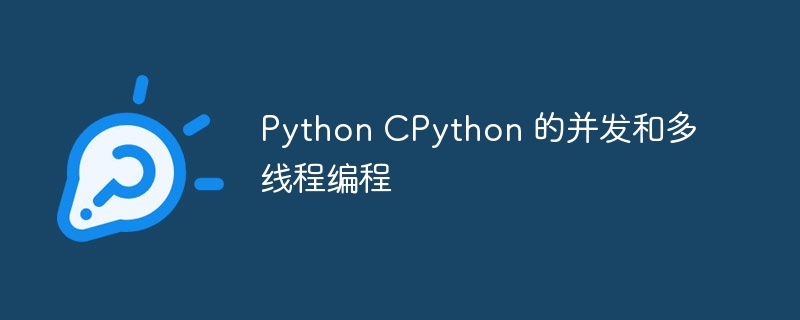Home >Backend Development >Python Tutorial >Concurrency and multi-threaded programming with Python CPython
Concurrency and multi-threaded programming with Python CPython
- WBOYWBOYWBOYWBOYWBOYWBOYWBOYWBOYWBOYWBOYWBOYWBOYWBforward
- 2024-03-05 11:19:46825browse

1. Concurrent programming in Python CPython
Concurrent programming is a programming paradigm that allows multiple tasks to be performed at the same time. In python CPython, Concurrent programming is mainly implemented in two ways: Multi-threading and coroutines.
2. Multi-threaded programming
MultipleThreadsProgramming is a technology that uses multiple threads to perform different tasks at the same time. Python CPython provides the threading module to create and manage threads. The following code example demonstrates how to use multithreading to perform concurrent tasks in Python:
import threading
def task(name):
print(f"Task {name} started")
# 执行任务
print(f"Task {name} finished")
# 创建线程
threads = []
for i in range(5):
thread = threading.Thread(target=task, args=(i,))
threads.append(thread)
# 启动线程
for thread in threads:
thread.start()
# 等待线程完成
for thread in threads:
thread.join()
3. Coroutine programming
Coroutines are a lightweight alternative to concurrency that allow multiple functions to be paused and resumed in the same thread. Python CPython provides support for coroutines through the async<strong class="keylink">io</strong> module. The following code example demonstrates how to use coroutines to perform concurrent tasks in Python:
import asyncio
async def task(name):
print(f"Task {name} started")
# 执行任务
print(f"Task {name} finished")
# 创建事件循环
loop = asyncio.get_event_loop()
# 创建协程任务
tasks = []
for i in range(5):
task_coroutine = task(i)
tasks.append(task_coroutine)
# 将协程任务添加到事件循环
for task_coroutine in tasks:
asyncio.ensure_future(task_coroutine)
# 运行事件循环
loop.run_until_complete(asyncio.gather(*tasks))
4. Comparison between multi-threading and coroutine
Multi-threading and coroutines are both effective technologies for implementing concurrent programming, but each has its own advantages and disadvantages.
- Multithreading:
- Advantages: Easy to use, native support, suitable for CPU-intensive tasks.
- Disadvantages: Large overhead, complex thread synchronization.
- Coroutine:
- Advantages: Less overhead, simpler thread synchronization, suitable for IO-intensive tasks.
- Disadvantages: It is relatively complex to use and has a certain dependence on the underlying implementation.
5 Conclusion
Python Concurrent programming in CPython provides powerful mechanisms to improve application performance and responsiveness through multi-threading and coroutines. When choosing a concurrency technology, you should weigh the trade-offs based on the type of task and your specific needs. Through the correct use of concurrent programming technology, you can give full play to the concurrent processing capabilities of Python CPython and build high-performance and scalable applications.
The above is the detailed content of Concurrency and multi-threaded programming with Python CPython. For more information, please follow other related articles on the PHP Chinese website!

